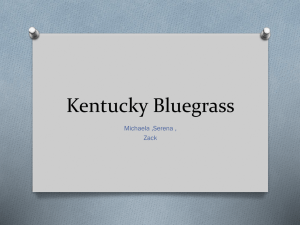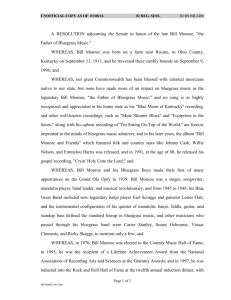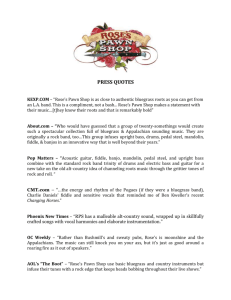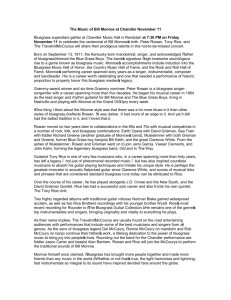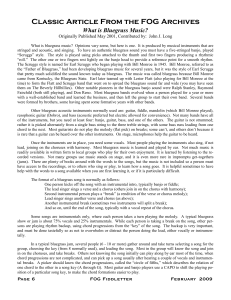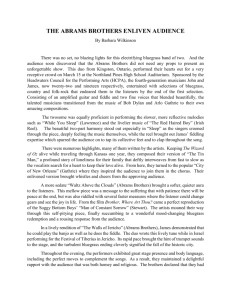“The Good Times are Past and Gone”: The History of Bluegrass
advertisement
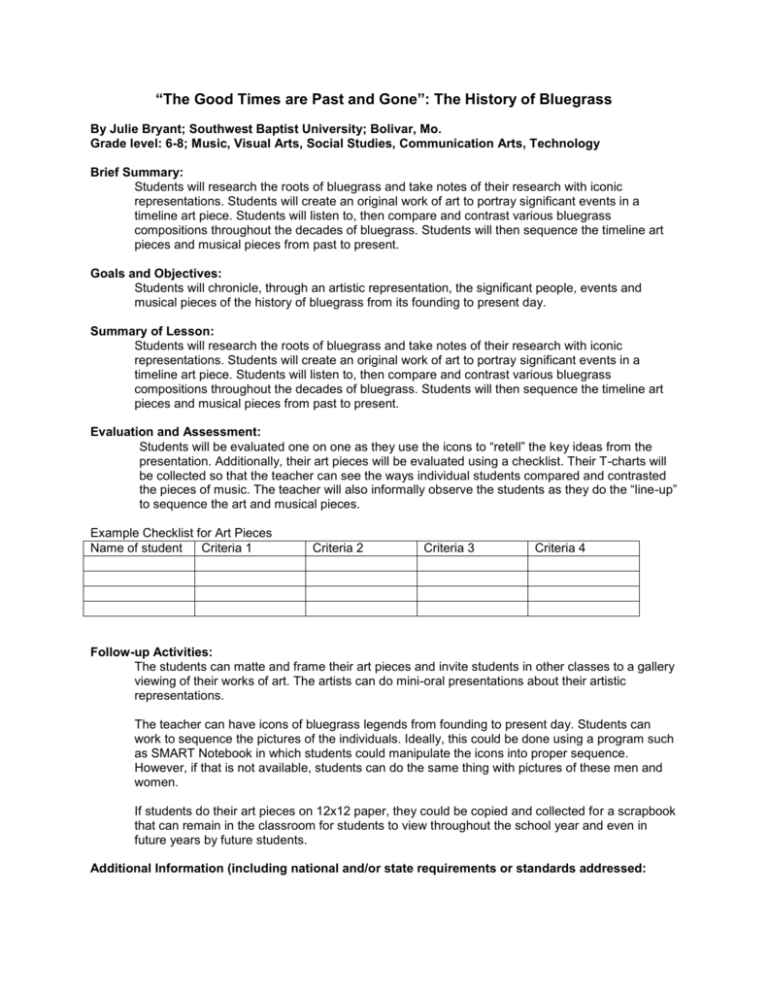
“The Good Times are Past and Gone”: The History of Bluegrass By Julie Bryant; Southwest Baptist University; Bolivar, Mo. Grade level: 6-8; Music, Visual Arts, Social Studies, Communication Arts, Technology Brief Summary: Students will research the roots of bluegrass and take notes of their research with iconic representations. Students will create an original work of art to portray significant events in a timeline art piece. Students will listen to, then compare and contrast various bluegrass compositions throughout the decades of bluegrass. Students will then sequence the timeline art pieces and musical pieces from past to present. Goals and Objectives: Students will chronicle, through an artistic representation, the significant people, events and musical pieces of the history of bluegrass from its founding to present day. Summary of Lesson: Students will research the roots of bluegrass and take notes of their research with iconic representations. Students will create an original work of art to portray significant events in a timeline art piece. Students will listen to, then compare and contrast various bluegrass compositions throughout the decades of bluegrass. Students will then sequence the timeline art pieces and musical pieces from past to present. Evaluation and Assessment: Students will be evaluated one on one as they use the icons to “retell” the key ideas from the presentation. Additionally, their art pieces will be evaluated using a checklist. Their T-charts will be collected so that the teacher can see the ways individual students compared and contrasted the pieces of music. The teacher will also informally observe the students as they do the “line-up” to sequence the art and musical pieces. Example Checklist for Art Pieces Name of student Criteria 1 Criteria 2 Criteria 3 Criteria 4 Follow-up Activities: The students can matte and frame their art pieces and invite students in other classes to a gallery viewing of their works of art. The artists can do mini-oral presentations about their artistic representations. The teacher can have icons of bluegrass legends from founding to present day. Students can work to sequence the pictures of the individuals. Ideally, this could be done using a program such as SMART Notebook in which students could manipulate the icons into proper sequence. However, if that is not available, students can do the same thing with pictures of these men and women. If students do their art pieces on 12x12 paper, they could be copied and collected for a scrapbook that can remain in the classroom for students to view throughout the school year and even in future years by future students. Additional Information (including national and/or state requirements or standards addressed: All standards come from the Grade Level Expectations for the state of Missouri and are aligned with the National Standards when appropriate. Describe ways in which principles and subject matter of other disciplines are interrelated with those of music (Music, Interdisciplinary Connections, 1 B, 6-8, National Standard MU 8) Identify music from various styles and historical periods by comparing/contrasting selected elements of music (Music, Historical and Cultural Contexts, 1 A, 6-8, National Standard MU 9) Use a variety of media to create texture (Visual Art, Product/Performance 1 A, 7, National Standard VA 1) Use a variety of brush strokes to create smooth area, texture. Create a variety of colors, tints, shades by mixing (Visual Art, Product/Performance, 1 B, 6-8, National Standard VA 1) Create original artwork that communicates ideas (Visual Art, Product/Performance, 3 C, 6-8, National Standard VA 1) Use center of interest/focal point (Visual Art, Elements and Principles, 2 B, 7, National Standard VA 2) Describe how ideas, concepts, and traditions have changed over time (Social Studies, Relationships of Individuals and Groups to Institutions and Traditions, 6 I, 6-8, SS 6) Create maps, graphs, timelines, charts, diagrams to communicate information (Social Studies, Tools of Social Science Inquiry, 7 B, 6-8, Standard SS 7) Use technological tools for research and presentation (Social Studies, Tools of Social Science Inquiry, 7 D, 6-8, Standard SS 7) Identify and describe the significance of individuals who have made contributions to our state and national heritage (Social Studies, U.S. and World History, 3a B, 6-8, Standard SS 3) Describe how the contributions of scientists and inventors, representing different cultures, races, and genders have contributed to science, technology, and human activity (Science, Impact of Science, Technology, and Human Activity, 2 A, 6-8) Apply decoding strategies to “problem solve” unknown words when reading when needed (Communication Arts, Reading, 1 C, 6-8, Standard CA 2) Develop vocabulary through text using context clues, dictionary (Communication Arts, Reading 1 D, 6-8, Standard CA 2) Apply pre-reading strategies to aid comprehension (Communication Arts, Reading 1 F, 6-8, Standard CA 2) During reading, utilize strategies to visualize, paraphrase, summarize (Communication Arts, Reading, 1 G, 6-8, Standard CA 2) Apply post-reading skills to comprehend, interpret, analyze, and evaluate text: reflect, paraphrase, summarize (Communication Arts, Reading 1 H, 6-8, Standard CA 2) Identify and explain text features in biography and autobiography (Communication Arts, Reading 3 A, 6, Standard CA 3) Use details from text to paraphrase or summarize author’s stated ideas (Communication Arts, Reading, 3 C, 6 and 7, Standard CA 3) Follow a writing process to pre-write, draft, revise for audience and purpose, share writing (Communication Arts, Writing, 1 A, 6-8, Standard CA 1) Compose text showing awareness of audience, choosing a form appropriate to topic and audience (Communication Arts, Writing, 2 A, 6 and 7, Standard CA 4) Compose text with a clear beginning, middle, end using a variety of sentence structures (Communication Arts, Writing, 2 C, 6-8, Standard CA 4) Resources Used: Audio Resources Visual Resources Internet Resources http://www.ibma.org http://www.ibma.org/about.bluegrass/history/index.asp http://www.jacktuttle.com/timeline.htm http://www.zianet.com/elm-st-station/blu-hist.html http://www.bluegrass-museum.org/masters/history.htm Objectives: Students will chronicle, through an artistic representation, the significant people, events and musical pieces of the history of bluegrass from its founding to present day. Materials used: computers with Internet access SMART Notebook or similar program to display graphic or clip art paper and writing tools for taking notes sturdy paper (11x14 or 12x12) paint, brushes, paint shirts or smocks materials for collage—of various textures, shapes, sizes adhesive materials for matting and framing pictures small tags for labeling the art piece CD player and CDs of various bluegrass legends from past to present. Prior Knowledge and Experience/Curriculum Content: Students should be comfortable with paraphrasing or summarizing key ideas from text. This lesson integrates Music, Visual Art, Social Studies, Communication Arts, and Technology. Procedures: 1. The teacher will activate students’ prior knowledge by holding a discussion about the type of music called bluegrass music. The discussion will include vocabulary regarding instrument types, titles of songs, and the names of some of the legends of bluegrass. The teacher will explain the objective for the lesson is that students will be able to create a work of art that represents the significant people, events, and musical pieces of the history of bluegrass music. 2. The teacher will model for the students how to take notes and use iconic representation to help them make connections with the text. Ideally, the teacher could use graphic or clip art on a SMART Notebook program. However, if this is not available, the teacher can either do the program in Microsoft Word or he/she can also draw them on chart paper or on the white board. For example, one fact might be that early bluegrass music was called “mountain music,” so the teacher and students could draw a little mountain to represent this fact. Another example is that the Monroe Brothers were a legendary duet, so the teacher and students could draw two music notes labeled M.B. See attachment for teacher presentation. 3. The teacher will do a presentation on the history of bluegrass using iconic representations. The students will be asked to write down the facts and draw their own pictures after those modeled. The students will then do additional research to add to their iconic notes. 4. Students will use the following link(s) to research the historical people, events, and music. http://www.ibma.org/about.bluegrass/history/index.asp and/or http://www.jacktuttle.com/timeline.htm and/or http://www.zianet.com/elm-st-station/blu-hist.html and/or http://www.bluegrass-museum.org/masters/history.htm 5. While visiting the sites, students will use reading strategies to decode unknown words such as using context clues or dictionaries. They will take notes of what they discover about the historical events, people and music by summarizing or paraphrasing the author’s text. 6. For each important fact that the students write down in their notes, they will draw a small picture or iconic representation of that fact. The idea is that when students later look at just the icons, they will be able to recall the facts simply by seeing the image that represents the fact. 7. From there, students will be given sturdy paper and art materials including paint, adhesive, and textured paper for doing a collage. Students will select one significant event or person they learned about from their study about the history of bluegrass and will portray that person or event in a painting or collage. (The teacher may wish to assign events to assure that there is a representation for most of the significant events in the history of bluegrass.) 8. Students may work with paint colors to create various shades and tints or a variety of media to create various textures in their artwork. 9. The teacher will emphasize how the person or significant event should be the focal point of the piece so that it will easily communicate ideas about that part of history. 10. Students will then be given materials to frame their art pieces and label them with a small tag that reveals the title of the piece, the date (year, month, etc.) that it represents in the history of bluegrass, and the name of the student artist who created the art. 11. Next, the teacher will model how to use a T-chart. He/she will label one side “Older Pieces of Music” and the other side “Newer Pieces of Music.” 12. The teacher will then use the CD player to play three older bluegrass songs performed by the historical legend of bluegrass and then will play the same three bluegrass songs performed by more recent or modern legends of bluegrass. 13. The students will be asked to compare and contrast the two versions of each song using their own T-chart patterned after the one the teacher explained. 14. Using their completed T-charts along with their iconic representations from their notes, the students will use the writing process to write a five paragraph essay with a clear beginning, middle, and end about the history of bluegrass music. Subjects for the paragraphs can include how music affected history, how the contributions of the pioneers of bluegrass influenced our heritage, and how the various inventors of the original instruments impacted human activity. 15. The students will then get into groups and share their iconic representations from their notes, their art piece, and their thoughts regarding how the bluegrass music pieces have or have not changed. 16. The teacher will ask the students to do a historical event/person line-up. Each student will take his/her art piece and line up in sequential order with classmates from the earliest historical events to those that represent more modern events. 17. After the students have done their line-up, the art pieces can be collected in order and then displayed in a pictorial historical timeline. Indicators of Success: Students will use their iconic representations to “retell” significant events from the presentation and their additional research. Students will have represented, in a work of art, one significant person or event from the history of bluegrass. Students will be able to express their thoughts on similarities and differences in bluegrass music from long ago and today. Students will be able to sequence the significant historical events/people associated with bluegrass music. Supplementary Information: The format of this lesson is so that it could be accomplished in an integrated day because it encompasses all areas of the arts and many subject areas. It should be up to individual teachers whether the lesson is broken down into parts or taught in its entirety. Attachments: Iconic Bluegrass History (All information came from www.ibma.org) Early 1600s American immigrants from Ireland, Scotland, England and Africa are credited for bringing their personal music and contributing to the roots of bluegrass music. (flags and roots) Africa—banjo, Spain—guitar, Italy—fiddle, mandolin & bass, Czech immigrants to U.S.—Dobro (outline of Africa, Spain, Italy, Czech Republic) 1700s-1900s Early settlers spread to the rural areas of the NC, SC, TN, KY, VA, WV and composed songs called mountain music or country music that reflected their lives in the hills and on farms. (mountain) Early 1900s The phonograph and radio were invented and spread the mountain music all over the U.S. Names of good singers began to emerge: Jimmie Rodgers, the Carter family and the Monroe Brothers. (radio) 1920s and 1930s The most popular duet was the singing harmony of the Monroe Brothers from KY featuring Charlie on guitar and Bill on mandolin. (two music notes labeled M B) 1938 The Monroe Brothers split up to form their own bands. Because he was from “the bluegrass state,” Bill called his group “Bill Monroe and the Blue Grass Boys,” and their sound changed country music. (blue + grass) 1939 Bill’s group appeared on the Grand Ole Opry and became a popular touring band out of Nashville. Their music featured acoustic instruments and vocal harmony that combined musical influence from work songs of black laborers, string band, country, blues and gospel. The selected acoustic instruments were mandolin, fiddle, guitar, banjo and bass. (icon of Grand Old Opry, then one of each of the instruments) 1945 Earl Scruggs from NC joined “Bill Monroe and the Blue Grass Boys” and brought his three-finger picking style to the banjo. This style became known as “Scruggs style.” (three fingers and a banjo) Bill Monroe—mandolin, Earl Scruggs—banjo, Lester Flatt—guitar, Chubby Wise—fiddle, Howard “Cedric Rainwater” Watts—bass (pics of them and instruments) 1949 Flatt and Scruggs formed their own band “The Foggy Mountain Boys” and added the resophonic guitar or Dobro to the band. (fog + mountain) 1949-1969 Flatt & Scruggs introduced bluegrass music to America through appearances at universities, coliseums, school houses and television. People referred to the style and sound of this music as “bluegrass music.” Scruggs wrote and recorded “Foggy Mountain Breakdown” during this time. Bill Monroe became known as “Father of Bluegrass Music.” (fog + mountain + break+ down) 1955-1969 Burkett H. “Uncle Josh” Graves from TN adapted the “Scruggs style” of picking to the slide bar resophonic instrument adding his own bluesy style to the Dobro. (Dobro) 1960s “Bluegrass festivals” were introduced to feature bands competing with one another on the same schedule at weekend festivals across the U.S. It is believed that Carlton Haney produced the first weekend-long bluegrass music festival in VA in 1965. (R.V. and banjo) 1969 Scruggs and his sons formed their own band called “The Earl Scruggs Revue” which still records and performs today. Flatt started his own group called “The Nashville Grass” and performed with them until he passed away in 1979. (Flatt arrow left, Scruggs arrow right) 1970s-1990s and 2001 Bluegrass became more popular with availability of music recordings, nationwide bluegrass festivals, and bluegrass music featured on commercials, television, and movies such as Martha White Flour, The Beverly Hillbillies, Bonnie and Clyde, Deliverance, and O Brother, Where Art Thou?. (television and movie reel) 1996-1997 Bill Monroe passed away and was inducted into the Rock and Roll Hall of Fame, The Country Music Hall of Fame, and the Bluegrass Music Hall of Honor. (electric guitar, guitar, banjo) Present day Bluegrass music is represented in all 50 states and countries around the world. Early influences still touch the music of today, along with inspiration from jazz, contemporary country, Celtic, Southern gospel, and rock & roll. (U.S. labeled on the world)
